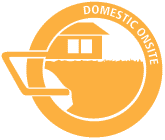


|

|

|
|
|
Services Domestic Onsite |  | |
| | |
| | |
This market is often called 'on-site', deriving their name from the treatment location.
These systems treat effluent close to the source, typically providing treatment on the
property of individual home or business. The source includes all types of human waste and
household water uses from the bathroom, kitchen and laundry.
What is Onsite
The initial stage of a secondary treatment system is where sedimentation, flocculation, flotation and anaerobic digestion processes take place. During secondary treatment aerobic digestion, clarificationand disinfection occur.
Types of secondary treatment systems are:
- Aerated Wastewater Treatment Systems (AWTS)
- Sand, textile and media filters
- Biological filters
- Reed beds
- Mound systems
Netafims Onsite Dripperline Dispersal System uses a secondary treatment system to disperse treated effluent safely and effectively directly into the soil.
This allows the treated water to be dispersed through a designated soil profile. A Netafim dripperline system is an option for this means of dispersal. It is recommended that a minimum water quality of secondary treated effluent is suitable for Netafim dripperline dispersal systems.
Problems - Health and Environmental
All onsite systems have risks associated with the interaction of humans to a dispersal system. These systems are installed in household gardens and turf areas which is susceptible to human containination if the system overflows or run-off occurs. It is critical in design, installation and especially maintenance that these issues are addressed. Netafimís dripperline dispersal system offers piece of mind solutions to these problems.
How Netafim UniBioline Subsurface Drip Systems work
Netafim's subsurface drip dispersal delivers a slow and precise application of treated effluent evenly throughout the soil. This maintains the perfect environment for further treatment of the effluent and delivers essential nutrients and moisture to the grass and plants.
The UniBioline dripperline is made of a 17mm diameter flexible polyethylene tubing with evenly spaced emitters. The water is pumped through the dripperline and discharged through pressure compensating non-leakage emitters ensuring an even, slow distribution of the effluent into the soil.
The Netafim Advantage
- Ideal for difficult site conditions such as clay, shallow soils, steep slopes, high water tables
- Best technology available for recycling of water and the re-use of nutrients when used for landscape irrigation
- Eliminates health risks associated with dispersal methods that allow wastewater to surface or become airborne
- Requires a minimum of soil below the drip tubing
- Achieves a balanced water distribution throughout a shallow profile by directly applying the effluent to the plants root zone
- Ensure uniform distribution of effluent for a long system life
- Dosing and resting cycles take full advantage of the treatment capabilities of the soil for cleaner water in the aquifer
- Does not disturb landscape during installation
|
|
|

